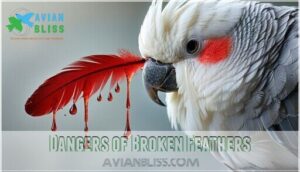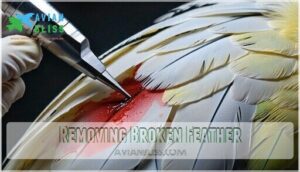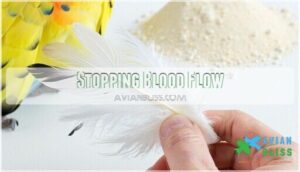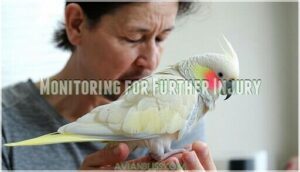This site is supported by our readers. We may earn a commission, at no cost to you, if you purchase through links.
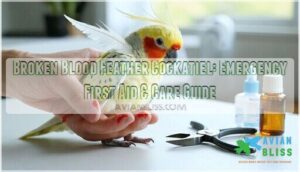
Don’t panic, but act fast. The hollow shaft bleeds continuously until you remove the entire feather from its follicle.
You’ll need needle-nose pliers, styptic powder, and steady hands. Restrain your bird gently but firmly, grasp the feather close to the skin, and pull straight out with one quick motion.
Apply styptic powder to stop bleeding and monitor closely. Recovery involves creating a stress-free environment while watching for complications.
The removal technique and aftercare steps can save your bird’s life.
Table Of Contents
- Key Takeaways
- Broken Blood Feather
- Dangers of Broken Feathers
- First Aid for Broken Feathers
- Caring for Injured Cockatiel
- Healing and Regrowth Process
- Frequently Asked Questions (FAQs)
- Will a broken blood feather heal on its own?
- What to do if a cockatiel breaks a blood feather?
- Should I remove a blood feather?
- Will a broken blood feather heal itself?
- Can a bird survive a blood feather?
- How to remove a broken blood feather?
- Why is my broken blood feather not bleeding?
- What happens if a bird breaks a blood feather?
- What is a broken blood feather?
- What should I do if my bird has a broken blood feather?
- Conclusion
Key Takeaways
- Act immediately when you spot active bleeding – Blood feathers contain a live blood supply, so you’ll need to restrain your bird and remove the entire broken feather with needle-nose pliers in one quick motion.
- Apply styptic powder and direct pressure – After removal, you’ll stop the bleeding by applying styptic powder or cornstarch to the wound site and maintaining steady pressure for 10-15 minutes.
- Create a stress-free recovery environment – You’ll need to remove toys and rough perches from the cage, maintain quiet surroundings, and limit your bird’s movement to prevent re-injury.
- Monitor closely for complications – You’ll want to watch for continued bleeding, signs of infection like swelling or discharge, and behavioral changes that indicate pain or distress requiring veterinary attention.
Broken Blood Feather
You’ll encounter a blood feather emergency when your cockatiel’s growing feather breaks and won’t stop bleeding.
These immature feathers contain an active blood supply, making them particularly vulnerable to trauma during your bird’s molting periods.
Definition of Blood Feather
A blood feather is basically a "baby feather" actively growing with a live blood supply running through its hollow shaft.
Think of blood feathers as your cockatiel’s vulnerable growing plumage—soft, blood-filled, and easily damaged during molt season.
You’ll typically spot these developing feathers during your cockatiel’s molting season when new plumage emerges.
Key Blood Feather Characteristics:
- Dark, visible blood supply running through the center shaft (called the rachis)
- Soft, waxy coating protecting the developing feather structure
- Occurs during molting periods when old feathers shed and new ones grow
- Most vulnerable to breaking due to their soft, blood-filled composition
Causes of Broken Feather
Trauma tops the list when your cockatiel faces feather injury.
Cage accidents from overcrowded spaces, rough handling during capture, and vigorous wing flapping cause most broken blood feathers.
Night frights trigger panic episodes, leading to thrashing and feather trauma.
Poor wing clipping exposes vulnerable new growth, while molting vulnerability makes developing feathers fragile and prone to breaking during routine activities.
In such cases, bleeding requires management to prevent further complications.
Identifying Broken Feather
Quick identification prevents life-threatening blood loss in your cockatiel.
Look for actively bleeding immature feathers with visible blood at the shaft during feather examination.
Watch for cockatiel behavior changes like lethargy or distress.
Check for feather deformity, bent shafts, or bleeding signs around wing areas.
A broken blood feather requires immediate bird first aid—contact your avian vet for cockatiel bleeding emergencies involving feather injury.
Dangers of Broken Feathers
When a blood feather breaks in your cockatiel, you’re facing a serious medical emergency that requires immediate action.
The dangers extend far beyond simple bleeding, potentially threatening your bird’s life through blood loss, infection, and severe stress.
Severe Bleeding
When your cockatiel breaks a blood feather, you’re facing a genuine bird emergency that can quickly turn serious.
The rich blood supply in growing feathers means cockatiel bleeding can be rapid and alarming.
Blood loss from broken feathers poses immediate risks:
- Anemia risk develops as your bird loses essential red blood cells
- Emergency vet visits become necessary when bleeding won’t stop
- Clotting factors may be overwhelmed by continuous blood flow
- Transfusion needs can arise in severe cases requiring avian vet intervention.
Quick action with proper bird first aid techniques helps stop bleeding before it becomes life-threatening.
Infection Risk
Beyond bleeding, open feather shafts create entry points for bacterial threats like Staphylococcus and fungal concerns including Aspergillus.
Your cockatiel’s wound needs immediate attention through proper wound care to prevent infection.
Without preventative hygiene measures and potential antibiotic use, these bird emergency situations can escalate quickly.
Addressing potential causes such as poor sanitation and ventilation is vital in preventing fungal infections.
Professional blood feather treatment guarantees your bird’s avian health stays on track during recovery.
Stress and Trauma
A broken blood feather can trigger intense fear responses in your cockatiel.
The pain and handling stress often lead to behavioral changes that persist beyond physical healing. Your bird may develop feather plucking habits or withdraw from social interaction as coping mechanisms.
- Trauma triggers: Sudden movements or touching near the injury site can cause panic
- Fear responses: Your cockatiel may become defensive, biting, or refusing to perch normally
- Behavioral changes: Watch for increased vocalization, loss of appetite, or hiding behaviors
Environmental enrichment and gentle interaction support emotional recovery during cockatiel health crises.
First Aid for Broken Feathers
When your cockatiel breaks a blood feather, quick action can prevent serious complications and potentially save your bird’s life.
You’ll need to act fast but stay calm to provide effective emergency care that stops the bleeding and protects your pet from further injury.
Restraining The Bird
Following an emergency, you’ll need to safely restrain your cockatiel to prevent further injury and enable proper bird wound treatment.
The towel technique provides the most secure grip while minimizing stress on your bird’s delicate system.
| Restraint Method | Stress Level | Safety Rating |
|---|---|---|
| Bare Hands | High | Low |
| Light Towel | Medium | High |
| Thick Towel | Low | Very High |
| Gloves Only | Very High | Medium |
Use gentle approach techniques with a soft towel, covering your cockatiel’s head first to reduce visual stimuli.
Maintain safe holds around the body while avoiding the chest area to prevent breathing difficulties.
This method prevents feather plucking behaviors and guarantees proper cockatiel health during the emergency procedure.
Gathering Medical Supplies
Before you begin action, make certain you’ve got the right tools within arm’s reach. Having your supply checklist ready transforms a stressful emergency into a manageable situation, making cockatiel care more effective during blood feather removal procedures.
Essential supplies you’ll need:
- Clean towels or gauze – for immediate bleeding control and gentle restraint during the emergency
- Styptic powder or cornstarch – to quickly stop bleeding once the damaged pin feather is addressed
- Needle-nose pliers (sterilized) – for safe feather extraction, ensuring proper tool sterilization prevents infection risks
Consider specialized avian formulas for ideal care. Keep antiseptic solutions nearby for wound cleaning, though bandaging options aren’t typically needed for feather injuries. Quick preparation now supports successful feather regrowth later.
Removing Broken Feather
With supplies ready, grip the broken feather shaft using sterilized needle-nose pliers near the skin base. Apply steady pressure while pulling in one smooth motion following the feather’s natural growth direction.
Tool sterilization prevents infection during safe extraction. If you’re uncomfortable performing this procedure, seek professional help immediately.
The pin feather should come out completely with its rounded base intact, ensuring proper feather regrowth and preventing cockatiel care complications. Many retailers offer various plier options.
Stopping Blood Flow
Once you’ve secured the damaged feather, apply direct pressure with gauze for 10-15 minutes.
Sprinkle styptic powder or cornstarch on the bleeding site – these clotting agents work like magic to stop blood flow. For specialized avian care, consider styptic powder options.
Keep steady pressure without peeking; preventing re-bleeding requires patience. If bleeding persists beyond 15 minutes, seek veterinary help immediately for this serious cockatiel injury.
Caring for Injured Cockatiel
After first aid treatment, your cockatiel needs careful monitoring and a stress-free recovery environment.
You’ll want to watch for signs of continued bleeding, infection, or other complications while providing gentle supportive care.
Providing Safe Environment
Once your bird’s bleeding stops, creating a calm space becomes your top priority. Your feathered friend needs peace to recover from this traumatic feather problem.
Here’s how to set up their recovery space:
- Cage Safety: Remove all toys and perches that could snag delicate new feather growth
- Perch Materials: Replace rough surfaces with soft, padded perches to prevent further trauma
- Flight Space: Limit movement by covering three cage sides, reducing stress on your recovering pet
Keep the environment quiet and dim. Your avian companion’s healing depends on avoiding trauma during this vulnerable period.
Monitoring for Further Injury
After establishing your pet bird in a secure environment, watch closely for additional injuries that could complicate recovery.
Check for continued bleeding from the wound site or nearby feathers, which signals incomplete treatment.
Look for behavior changes like lethargy, appetite loss, or unusual posturing that might indicate pain or infection signs such as swelling around the affected area, which could be a sign of infection.
Offering Supportive Care
Beyond checking for continued bleeding and signs of distress, you’ll need to provide thorough supportive care. Your cockatiel needs extra comfort measures during recovery to heal properly and prevent complications.
Focus on these supportive care elements:
- Nutritional Support – Offer high-quality pellets, fresh vegetables, and cooked eggs to promote tissue repair
- Comfort Measures – Maintain cage temperature at 85-90°F and provide soft bedding for resting
- Reducing Stress – Keep the environment quiet and limit handling to essential care only
- Environmental Enrichment – Remove high perches temporarily while allowing gentle mental stimulation
- Veterinary Follow-up – Schedule check-ups to monitor healing progress and address any complications
Proper feather care and ongoing bird care support your pet’s recovery journey. To prevent respiratory issues, make certain you regulate cage humidity.
Healing and Regrowth Process
After your cockatiel’s emergency treatment, you’ll need to understand how the healing process works.
The recovery timeline and feather regrowth depend on several important factors that affect your bird’s natural healing ability.
Timeline for Healing
After you’ve provided proper bird care and veterinary care when needed, your cockatiel’s healing begins quickly.
Blood flow typically stops within 10-15 minutes with proper bleeding control. The healing stages progress rapidly – visible wounds heal within 48-72 hours in healthy birds.
Most cockatiels return to normal eating and activity within 2-3 days, showing no infection signs like swelling or discharge. Wound cleaning is essential to prevent infection during this time.
Regrowth speed varies, with new feather development starting immediately, though full feather quality restoration takes 4-6 weeks, which is a critical part of the recovery process and overall bird care.
Factors Affecting Healing Time
Your cockatiel’s healing speed hinges on several key factors.
Dietary impact plays a vital role—protein-rich nutrition accelerates recovery, while deficiencies slow progress.
Stress levels dramatically affect healing; calm environments promote faster repair than chaotic ones.
Cage hygiene prevents infections that complicate recovery.
Underlying conditions like illness extend healing time, and feather plucking behaviors can re-injure sites, prolonging the process substantially.
Feather Regrowth After Injury
After removal of a broken blood feather cockatiel, your bird will begin its natural feather regrowth process within several weeks.
The feather follicle remains healthy and produces new growth when provided proper nutritional support.
Quality protein, vitamins, and minerals guarantee strong feather development while preventing deformities.
Monitor post-regrowth care carefully, watching for signs of feather damage or recurring avian injuries during this vulnerable period.
Frequently Asked Questions (FAQs)
Will a broken blood feather heal on its own?
Like a ticking time bomb, a broken blood feather won’t heal on its own.
You’ll need to remove it or apply pressure to stop bleeding, as the damaged shaft continues bleeding until properly treated.
What to do if a cockatiel breaks a blood feather?
Apply direct digital pressure at the feather base for 1-2 minutes to stop bleeding. If bleeding continues, carefully pluck the broken feather or seek veterinary care immediately.
Should I remove a blood feather?
A bleeding feather is like a wounded lifeline—you’ll typically need to remove it to stop the bleeding.
Only a vet should safely extract broken blood feathers to prevent further trauma and infection.
Will a broken blood feather heal itself?
A broken blood feather won’t heal by itself and typically requires intervention. You’ll need to apply direct pressure or remove it to stop bleeding and prevent infection risks.
Can a bird survive a blood feather?
While bleeding wounds can look terrifying, your bird will likely survive a broken blood feather with proper care.
Apply gentle pressure immediately to stop bleeding.
Monitor closely for weakness or continued bleeding, then contact your avian veterinarian promptly.
How to remove a broken blood feather?
Grasp the feather shaft firmly with needle-nose pliers or hemostats near the skin.
Pull straight out in one quick, smooth motion.
Apply direct pressure with gauze to stop bleeding immediately afterward.
Why is my broken blood feather not bleeding?
Nearly 80% of blood feathers stop bleeding naturally within minutes due to the body’s clotting response.
Your cockatiel’s broken feather likely clotted already, but monitor for renewed bleeding during activity or preening sessions.
What happens if a bird breaks a blood feather?
When your bird breaks a blood feather, you’ll see active bleeding from the damaged shaft.
Apply direct pressure for 1-2 minutes to stop bleeding.
Monitor for infection signs like swelling or discharge afterward.
What is a broken blood feather?
A blood feather is an immature, actively growing feather with a live blood supply running through its shaft.
When you spot one that’s damaged or bleeding, it’s called a broken blood feather – a veterinary emergency requiring immediate attention.
What should I do if my bird has a broken blood feather?
Apply direct pressure to the bleeding feather’s base for 1-2 minutes.
If bleeding continues, gently pluck the broken feather completely out.
Monitor for infection signs and contact your avian vet immediately for guidance.
Conclusion
Knowledge is power when dealing with a broken blood feather cockatiel emergency.
You’ve learned the essential steps: swift restraint, proper feather removal, and bleeding control.
Remember, your quick thinking and steady hands can prevent serious complications.
Create a calm recovery environment and watch for signs of infection or continued bleeding.
While intimidating at first, mastering these techniques gives you confidence to handle future emergencies and keep your feathered friend healthy and safe.
- https://docs.google.com/forms/d/1GAQr3Kn1cURCVHUA82hAga1Wv8DCH0IuqDLRUrOpN7M/viewform?ts=63f4f653&entry.1515682415=https://www.merriam-webster.com/dictionary%2Fbroken
- https://premium.britannica.com/mw-unabridged/?utm_source=mw&utm_medium=inline-def&utm_campaign=evergreen
- https://dictionary.cambridge.org/us/dictionary/english/apart?topic=tearing-and-breaking-into-pieces
- https://www.drexotic.com/common-avian-emergencies/
- https://www.reddit.com/r/cockatiel/comments/q68c22/blood_stained_feather_need_advice/

